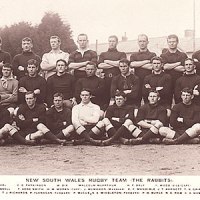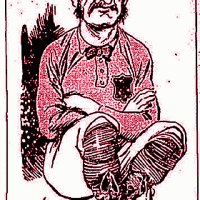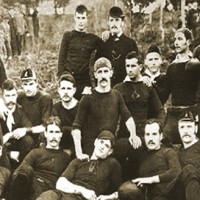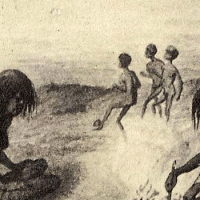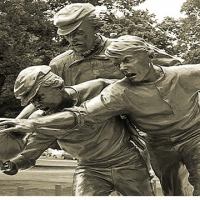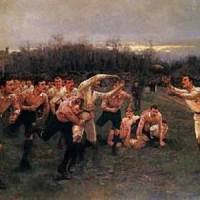HISTORY OF RUGBY IN NSW
written by Sean Fagan
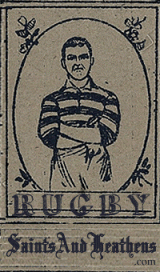 The Sydney Gazette and the Sydney Monitor reported in the late winter of 1829 that soldiers from the George’s Square Barracks were playing football games amongst themselves in their down time.
The Sydney Gazette and the Sydney Monitor reported in the late winter of 1829 that soldiers from the George’s Square Barracks were playing football games amongst themselves in their down time.
The Sydney Monitor account refers to football being a game “much played in Leicestershire” – somewhat significant given that the town of Rugby and its famed school are in the neighbouring Warwickshire county.
Traditional English folk football was played in Sydney through the 1830s to the mid-1860s, as part of the bill-of-fare at festivals and holiday celebrations.
In a letter to The Sydney Herald in 1832 (30 July edition) a writer called for police action as: “Last Sunday, during Devine Service, a large batch of youngsters were eagerly engaged in playing at football on Hyde Park. Have they no power to prevent the disgraceful pitched battles that take place weekly in the neighbourhood.”
In 1840 a football contest of some form took place on Hyde Park as part of celebrations marking the anniversary of Queen Victoria’s birthday (May 24). The Sydney Herald recorded: “There was also a game of football attempted which also gave rise to sundry scuffles and broken shins to boot.”
A year later a wide debate erupted about what activities ought to be permitted on Sundays. After he had banned recreational shooting on Sundays the Governor of NSW, Sir George Gipps, openly declared that he would swiftly ban any other amusement, “even football”, if it became such a Sunday nuisance that it began to impact on “the religious feeling of the community” (The Sydney Gazette, 10 June 1841).
In May 1846 on ‘Her Majesty’s Birthday’ anniversary day, a bill of ‘military amusements’ concluded with a night football match between ‘the grenadier and light companies’.
Though Sydney was the first settlement in the Australian colonies, by the middle part of the 19th century it had been usurped by Melbourne in terms of both population and economic power. Consequently, the movement towards organised football clubs lingered well behind the Victorian capital and the formation of the Melbourne FC in 1859.
However, some informal football appears to have been played, with a letter-writer to The Sydney Morning Herald (5 Dec. 1860) momentarily digressing from political matters to mention “…for the bare fun of the thing, the manhood of the colony will have a kick at the football.”
In Guardians of the Game, John G Mulford notes that in the 1850s workers at Sydney’s substantial ship yards in Mort’s Bay (Balmain) are likely to have played some form of traditional football against the crews of visiting ships.
Newspaper reports throughout the period of 1862-69 refer to football being played as part of public celebration days, picnics held by associations, volunteer groups and company’s for their staff, as well as traditional holiday community gatherings (such as on Easter Monday and Boxing Day), along with open days granted at the various private estates and mansions peppered throughout the city and nearby reaches (accessed via boat or rail).
Advertisements for steamer-ferry excursions from Circular Quay and Woolloomoollo Bay to various popular sites along the Sydney Harbour foreshore often included the playing of football (many “for which prizes are guaranteed to be given”) as amongst the day’s attractions on offer.
The Balmoral Gardens picnic ground at Middle Harbour was particularly popular, and The Sydney Morning Herald reported in 1864 (Saturday, Feb 27) of “football creating the most amusement from the number and variety of collisions”.
In Guardians of the Game the author details the commencement of rugby football in the city’s schools in the early 1860s.
Intriguingly, in its publications of 1859-60 and 1862-63, Sydney’s Albert Cricket Club reproduced in full the laws of football from Rugby School. While no evidence of any formalised football (outside of the schools) in NSW has been found in this period, the publishing of the rules suggests members of the Albert CC may have been playing the Rugby game amongst themselves.
It is likely that a conflux of happenings finally triggered the birth of formalised football in NSW with the founding of the “Sydney Football Club” in 1865 i.e. those already familiar with the game were joined by young men wanting to continue playing football after leaving school, together with the arrival of news and men familiar with what was happening with the playing and organising of football in Melbourne and in Britain.
An initial gathering of interested men was held at Lawrence’s Hotel in central Sydney on 30 May 1865, followed by a meeting at the same venue on 5 June where 40 members enrolled and the Sydney FC’s first playing rules were adopted. The club’s inaugural president was NSW politician and cricket administrator Richard Driver (Driver Avenue outside the SCG is named in his honour). The members of the Sydney FC played a game amongst themselves on 17 June at Hyde Park.
The first ‘inter-club’ match took place between Sydney FC and a team placed in the field by the Australian Cricket Club on 8 July 1865. The Sydney FC finished the day ahead one goal to nil, and in accordance with Rugby School tradition, the game continued on the following two Saturdays. No report has been found of which club ultimately won the match, although it is interesting to note that the second Saturday was played in “the presence of about six hundred spectators” [from The Sydney Morning Herald].
The Illustrated Sydney News, 15 July 1865:
“A football club, the first in the colony, has recently been formed and named the Sydney Football Club.”
Bell’s Life in Sydney, 22 July 1865:
“Judging from the large number of public who assembled on Hyde Park on Saturday last to witness the match between the Sydney and Australian Clubs, we think that it is not likely to lose ground by its importation from the old country. The only clubs at present formed for its promotion are the Sydney and the Australian.”
What influence these reports of football appearing in Sydney newspapers had on similarly spirited souls elsewhere in the colony is unfortunately not recorded, apart from a one-off comment in The Goulburn Herald (22 July 1865) which stated “A foot-ball club is in the course of formation in Goulburn.”
The first newspaper mention of students at the Sydney University playing football was an in-house contest (number of players per side not recorded) in preparation for a match against Sydney FC held on 19 August 1865. It has been generally accepted in Australian Rugby history that NSW’s first football club was founded at the University in 1863 or ’64, however, there is no documented evidence to confirm this, and the student enrolment numbers (not yet over 50 each year) suggest raising two football teams problematical.
None of the inter-club matches in Sydney in 1865 are thought to have been played under the full rules of Rugby School football, however the underlying principles and features were seemingly followed. The Sydney Mail reported in 1874 that Sydney football in the 1860s was a time when “each club had its own rules.”
The Sydney Morning Herald, 26 August 1865:
“A game of football was played on the University grounds on Saturday last, between the Sydney Football Club and members of the University. No goal was kicked.”
The Sydney Morning Herald, 2 June 1866:
“…not only is the [Sydney] Club favourably looked upon in this city, but that its fame (principally through the report of its excellent matches with the Australian and University Clubs) has extended to the neighbouring colony of Victoria…”
In 1866 a move to introduce ‘Victorian rules’ (later called Australian rules) to Sydney seems to have caused a rift between the clubs. In early June the Sydney FC announced it had adopted Victorian rules, and intimated a inter-colonial match (Sydney v Melbourne) was close to fruition.
Bell’s Life in Sydney (11 & 25 August) reported the University playing against a composite side of Sydney men and then the Military and Civil team, and in doing so described “fierce mauls” and the players running across the goal line for tries. The commencement of the cricket season meant the loss of the University Oval and ended prospect of any further matches for the year.
In 1867 unseasonably warm winter mitigated against interest in football, compounding the lack of enthusiasm caused by arguments over playing rules, and ultimately leaving only the University Club, and a team placed in the field by the Military and Civil Cricket Club, playing football (and that, according to Bell’s Life in Sydney 27 July, was under “Sydney University cum Rugby rules”). The same journal commenting on a University match added (17th August):
“Prior to next season a revision of the rules would be in my opinion very expedient, and much of the Rugby ball handling, which renders the game not football, and mainly contributes to these useless mauls, might with very great advantage be then got rid of.”
The four matches that comprised the 1867 football season were no longer played on what became the University’s cricket and rugby oval, but on the “University Paddocks” located between the University and St Paul’s College (see Bell’s Life in Sydney 9 March & 18 July 1867).
The writer for Bell’s Life in Sydney stating (18 July 1867) “From what I have observed however the interest taken in the game [football] in this colony is much smaller than in Victoria”, then adding (3 August) “It says little, however, for the pluck and stamina of our Colonial youths, that so few of them can be found willing and able to join in this stirring and manly pastime.”
Whether the difference between Sydney and Melbourne was caused by the nature and interests of each city’s youth, warmer weather in the NSW capital, and/or of the playing rules of football adopted wasn’t elaborated upon.
Club football was briefly revived in early July 1868 with the founding of a new Sydney FC. The Sydney Mail noted (July 4) that the club had twenty playing members, that the first game would be played against the University or the Military and Civil Club, and that the enthusiasm to form the club had been triggered by the growing interest for football clubs in Melbourne.
The Sydney Morning Herald (1 August) observed that:
“The old English game of football appears to acquire attractions for the inhabitants of Sydney every year. Several clubs are now in course of formation.”
It proved to be a “false dawn” for the sport in Sydney, and only four matches are known to have been played at all during 1868-69.
The largest obstacles to growth in the sport were a lack of grounds on which football could be played and disagreement over rules. The four matches of 1868-69 were held at the Victoria Barracks, the Domain (until being refused further use of it) and the University ground.
With warmer weather than Melbourne, cricket in Sydney continued to enjoy a 10-month long season, leaving football just July and August in which to live a brief existence free of competing intrests.
The Wallaroo FC was formed in 1870 to play “according to the Rugby rules” by William ‘Monty’ Arnold with his older brother Richard. Its initial impact was minimal, with the city again hosting a mere 11 matches through 1870-71. It was however at this time that football began being played by schoolboys at the King’s School and Newington College.
From 1872 onwards there was a rapid growth in the formation of football clubs. The increase in interest in football coincided with the population of Sydney rising by almost half – from 96,000 in the mid 1860s to just under 138,000 in 1871 – as the city began on the path towards overtaking Melbourne.
New gentlemen’s membership clubs and school teams competed against each other, notably the King’s School (playing on the Parramatta Domain), along with St. Leonards, Lyndhurst College, Camden College, Sydney Grammar School, Waratah FC, Balmain, Calder House (school at Redfern), Newington College and a handful of others.
In rural NSW the first country clubs were founded at West Maitland and Goulburn in 1872, with others at Bathurst, Mudgee, Murrurundi, Cooma, Singleton, Dubbo, Queanbeyan, Yass, Newcastle, Wollongong (‘Illawarra FC’) and Tenterfield known to have been formed and playing Rugby by 1879 (given the relative size and remoteness of some of these towns, it is probable many more regional centres will be found to have established a club around this time).
Having football played under the patronage of the schools (their teams were usually formed on a “past and present” basis) also provided a solution to the problem of the lack of playing fields in Sydney.
Credit must also be given to the leaders of the Wallaroos, who negotiated with the City Council and gained agreement for the use of Moore Park fields, within which the Sydney Cricket Ground and Sydney Football Stadium now stand, and the NSW Waratahs offices and training fields are located.
Lingering arguments over the differences in the playing rules followed by each club or school reached a head by 1874.
The Wallaroo club proposed a football conference of all teams to decide on a codified set of playing rules – unsurprisingly the Wallaroo members pushed for the adoption of Rugby rules, without any alteration. The initiative succeeded, and the Southern Rugby Football Union (later re-named as the NSWRU) was founded, adopting the English RFU’s laws.
In 1877 the NSWRU had thirteen member clubs from the twenty-three known to be playing rugby football in the colony: Balmain, Bathurst, Burwood, Camden College, Goulburn, Grammar School, King’s School, Maitland, Newington College, Oaklands, University, Wallaroo and Waratah.
To tighten its grip on the rugby game and the growth of rival codes, the Union adopted a rule that its clubs could only play other member clubs – proposed matches against ‘non-subscribing’ clubs had to receive prior approval.
During the 1877 season the Waratah FC met Melbourne’s Carlton FC in two matches (one under each set of rules) in Sydney, in attempt to showcase the attributes of both codes in the hope of forging a football unification between the two colonies.
The NSWRU stood firmly against the plan, rejecting all calls to amend the playing laws of rugby that would have brought football in NSW closer to that being played in Victoria. Shortly afterwards, the Waratah FC and other similarly-minded clubs founded an Australian rules football association in Sydney.
“Observer’s Sydney Items” in The Maitland Mercury, 11 June 1881:
“Football is all the rage here now. We have numerous clubs in Sydney, and three different styles of game are played, viz.: the Rugby game, the Victorian game, and the English Association game. The first named is liked by far the best….The Wallaroo, Redfern, University, Balmain, Sydney, East Sydney, Burwood, St. Leonards, Parramatta, Glenhead, Newington, Stanmore, King’s School, and Grammar School teams are looked upon as our best, whilst the four first named are classed A1.”
The NSW Rugby team (later called Waratahs) played its first inter-colonial games in 1882, against Queensland (later called ‘The Reds’), before making a tour of New Zealand. The NZrs visited NSW in 1884, and a British team toured Australia and New Zealand in 1888.
The exchange of visits led to the continued growth of Rugby, and by the 1890s the code firmly had hold of the colony, thwarting attempts by Australian rules and “British Association” (soccer) to gain the ascendancy.
In July 1907 a crowd of 52,000 filled the SCG to over-flowing to watch a game between NSW and the New Zealand All Blacks. The attendance was the largest of any “football” game held to date in Australia, rivalled the scale of the USA’s Harvard-Yale game, and was only bettered by the English (soccer) FA Cup Final.
However, it was this financial and popular success that ultimately led to a rift in NSW Rugby that split the code along the amateur v professional ideals (rugby league).
© Sean Fagan
*The contention that Sydney University club was not formed until August 1865 (i.e. after the Sydney and Australian FCs) is set out in They Ran With the Ball by Tom Hickie (page 43) and Guardians of the Game by John Mulford (page 11).
References.
Sean Fagan, The Rugby Rebellion
Thomas Hickie, They Ran With The Ball
Geoff Armstrong, The Father of Australian Rugby?
NSWRU / ARU archives
Newspapers as listed


